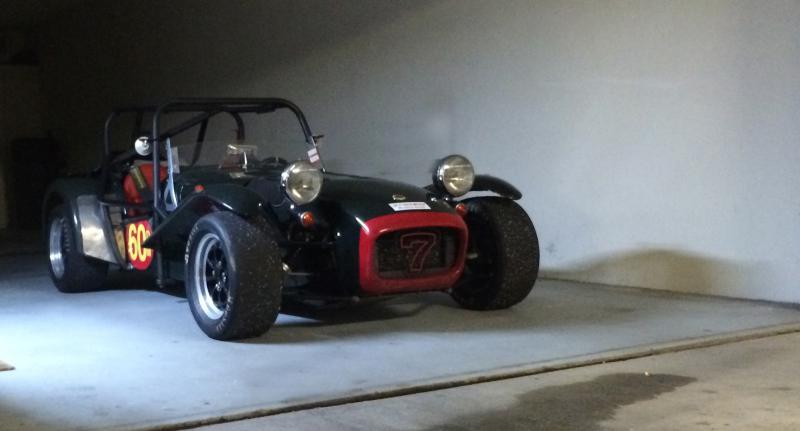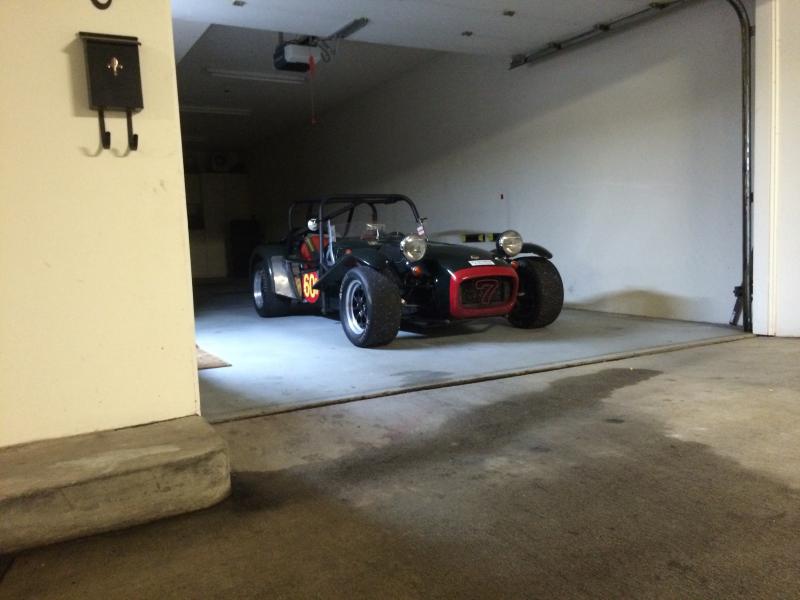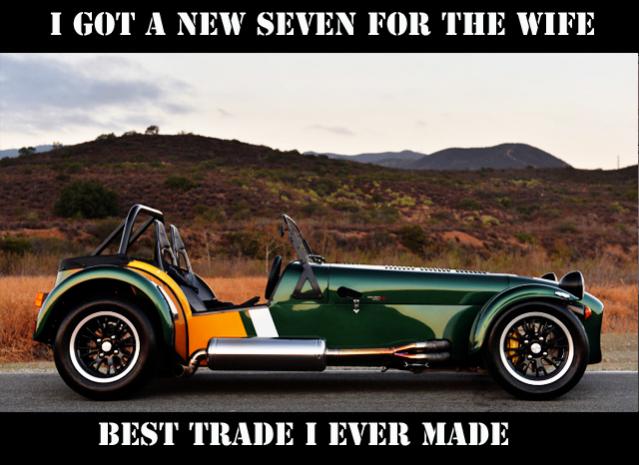-
Posts
788 -
Joined
Everything posted by MichaelD
-
Mike, I can look at the bill and tell you. The new motor was built by Quicksilver Racengines. It is basically a Formula Atlantic race engine detuned for pump gas. They say that with a race tune and race gas it can put out 245 hp.
-
Croc, I didn't know there was anything other than your list. I can post there as well.
-
Al, I live in downtown Bethesda and am only allowed 2 cars. The Z3 and Seven are in my garage. The X3 and trailer are in a rented spot 100 yds from my house. The owner passed away today and the property will be sold and demolished for redevelopment. Thus I think the timing is right to sell a GREAT SEVEN.
-
http://static.mjdtopsites.com/user_files/105/published/templates/51/b/images/layout/headers/topdocs7_1.gif This beautiful car was the first factory built Caterham Zetec in the US. In 2000, the frame was modified by Caterham in England to fit the Zetec and then shipped to Frank Bolton, the US Caterham distributor. It was then shipped to the SCCA for approval. When Mr. Bolton sold the distributorship to Jon Nelson he sold the car to George Alderman of Mid-Atlantic Caterham. George then sold it to me. http://static.mjdtopsites.com/user_files/105/uploads/2010dcautoshow11.jpg In the SCCA booth at the 2011 DC Auto Show In April 2011 a Full, Removable Cage was built by Piper Motorsport for extra protection during highway drives in DC Beltway traffic. The stock Zetec engine was also replaced with a brand new ZX3 motor from Quicksilver Racengines in June of 2011. It was tuned for pump gas and dynoed at 216 HP. Currently the car is registered in Maryland as assembled vehicle and includes Maryland lifetime emissions inspection waiver. I have used it as a weekend driver, autocross and track day car. http://static.mjdtopsites.com/user_files/105/uploads/P1000648.JPG Photo 3/2017 Fender vents eliminate lift and maintain classic looks. Technical features include: Jaguar Racing Green with Red Leather seats 216 HP Zetec by QuickSilver Racengines in Frederick, MD Motor Refreshed 12/2016 New Rotors and Pads , F & R 12/2016 TWM Throttle Bodies Heavy Duty Aluminum Radiator Pectel ECU with Software, Mapping CD and Laptop T9-5 Speed Trans standard ratios, Refreshed 12/2016 Light Flywheel & HD Clutch Quaife LSD Front Wide Track w Anti-Sway Bar Rear Watts w Adjustable Anti-Sway Bar Caterham Race shocks and springs Adjustable spring perches Full Heated Windshield Six inch short Windscreen Custom "Removable" Full Roll Cage FIA Roll Bar with strut Full Top with doors 5 - Prisoner Wheels with Toyo 888s Schroth 5pt Driver and 4 pt passenger belts Spare tire rack Price $35,900 Additional pictures and info on request Available with or after car sale: Brookland Screens $300 2nd, T9-5 Speed Trans standard ratios, Refreshed 12/2017 $1,700 4 - 13 x 10 Kodiak Wheels $1,500 2 - 13 x 9 - CR 500 Wheels $ 750 2 - 13 x 7 - CR 500 Wheels $ 750 New Set of Clam Shell fenders $600 Stock Roll Bar $200 Aluma "Custom Seven" Trailer 750 Lbs.C Bed stretched to fit extra tires tool box and car Ramps pull out from under bed Carries Up To 8 Extra Tires and Gear Box Includes 4 New Fenders & Spare Tire, Tool Box and Tie Downs Custom Aluma Trailer $2,250 http://static.mjdtopsites.com/user_files/105/uploads/CIMG2601.JPG My email MichaelD If interested please PM MichaelD
-

Kurtis Kraft Kar Wrap this week
MichaelD replied to lotusman1951's topic in General Sevens Discussion
Sounds like nice weather Saturday. I may stop by if I the the 7 out. -
Several years ago, Del Long ran his Seven in DM and them bolted 300lbs of sheet steel to the bottom of the car to make EM weight at Nationals. I don't know how he finished that year but he is always competitive. I think he had four bolts set then drove the car over the plate, jacket it up, added the nuts and drove off.
-
I have heard that the RA1s are also great turf tires as well.
-
Thanks for both comments. Anyone have cost estimates for a wrap?
-
I would like to get an idea of what the cost should be and what else might be involved in having my Seven with clams repainted. I guess I would take off the roll cage, front and rear fenders, tail lights and the seats just to be safe. How do you disconnect the clams from the stays? Anything else? Thanks for the feedback.
-
This is the site that really explains backspace and wheel fitment nicely. Hope this helps. http://www.rsracing.com/tech-wheel.html#backspace
-
Kevin, Looks like fun. Hope to see it in Feb. Michael
-
I bet this LARGE wind wings help minimize the cold air coming in. Did you make them?
-

The Regular Summary of Classified Ads of Se7ens Found For Sale
MichaelD replied to Croc's topic in Cars For Sale
-
Is there a part number for those Performance Friction pads for a Caterham? I have been having Porterhouse make me copies if the no longer available Hawk Caterham pads. I use regular brakes & roters not the uprated brakes & roters.
-

2016 Katie's Cars & Coffee Thread - Great Falls, VA
MichaelD replied to rcollum's topic in Mid-Atlantic
I think it looks better in the 3/4 view. Is the engine f,r or m engine? Why do you think is has less storage? -

2016 Katie's Cars & Coffee Thread - Great Falls, VA
MichaelD replied to rcollum's topic in Mid-Atlantic
I was referring to this one. http://www.usa7s.net/vb/attachment.php?attachmentid=11963&d=1479590583 -

2016 Katie's Cars & Coffee Thread - Great Falls, VA
MichaelD replied to rcollum's topic in Mid-Atlantic
Hi Bob, Thanks for the photos. What was that Alpha? -

The Regular Summary of Classified Ads of Se7ens Found For Sale
MichaelD replied to Croc's topic in Cars For Sale
Prego! -
$850 for mine including shipping.
-
Accurate tire temps should be taken as soon as you are off the track. Maybe have someone meet you at track out and take the temps before they cool down at all.
-

No longer a dreamer, now a 7 owner
MichaelD replied to Black Hole's topic in General Sevens Discussion
50 weight will help show higher OP. However the real problem is likely a bad Caterham OP gauge. Buy a cheap mechanical unit to test it out. Mine now shows 80 on start and 45 after a track session at idle and 80 under acceleration. And Oh Yes...welcome to our wacky world. -
First set your corner weights ( with your weight in the driver seat, a big bucket of stones will do) and get the car balanced the way you want it. I like mine as close to 50 x 50 x 50 x 50 as possible. Add a little toe out and take it for a track ride. Adjust as needed one item at a time and drive a few laps and adjust again. Adjustment advice for Caterham Academy follows: Ride Height Description Measured from the chassis rail to the floor just in front of the wishbone attachment point. This needs to be a minimum of 140mm for the Academy, although it is generally set at 145mm minimum as there is little benefit to running on the limit and this doesn’t allow for any suspension sag or tyre wear. It should be checked regularly. Track miles will wear out tyres and cause suspension to settle and sag a little. Adjustment To raise the ride height, the upper platform at the bottom of the spring/damper unit should be screwed further up (compressing the spring more). To lower the ride height, the top platform should be loosened (decompressing the spring). Once set, the lower platform should be tightened up to lock them in place. Benefit Lowered centre of gravity of the car. This aids in all cornering, braking and accelerating. Drawback Little drawback other than grounding out or sailing too close to the wind with the regulations. Camber Description Camber is the angle off vertical that the tyre leans sideways. It can be positive, where the tyre leans outwards, or negative, where the tyre leans inwards. You will only ever want negative camber. The regulations allow for 3 degrees negative camber at the front. Adjustment Normally, this is set at 2-2.5 degrees for Academy cars. Front camber is adjusted by releasing the top wishbone from the upright. The ball joint assembly is on a thread and ‘tightening’ the ball joint onto the wishbone will increase negative camber and ‘loosening’ the ball joint will decrease the negative camber. Rear camber is possible to achieve with metal shim inserts. The De-Dion has in built camber and for the Academy, it is rare to add any different setting as this reduces traction under acceleration. Benefit Adding negative camber allows tyre to sit flat on the road when leaning over under cornering load, therefore increasing tyre contact patch and so, grip under cornering. Drawback In a straight line there is a reduced contact patch on the tarmac and therefore less grip available to accelerating and braking. Caster Description Caster is the angle around which the front tyres pivot when being turned. (The front wheel of a bike has lots of caster). Adjustment Front caster is adjusted using the lower wishbone, by using washers to push the attachment points forward or backward. Factory set is even with two washers either side of the attachment points. It can be moved forward or backward where all 4 washers are one side of the attachment points. Rear caster is not relevant as the tyres do not turn. Benefit When the wheel turns, the caster adds additional camber. It is a way of getting more camber at the front of the car without breaking regulations. Most race engineers will want to set large amounts of caster. Drawback The trade off is heavy steering, making it harder to finesse the car and the car is less sensitive at turn-in. Driving style will determine whether these drawbacks are costing more time the the additional camber offers in grip. Toe Description Toe is the angle that the wheels point away from parallel to each other. Where the front of the tyre is closer to the car than the back of the car, that is toe in. Where the front of the tyre is further away from the car than the back, that is toe out. Toe out is set for Caterham’s as this makes the car eager to turn. Adjustment Caterham’s are generally set with a toe out maximum in the region of 1.5 degrees per side at the front. You adjust the toe of the front tyres by turning the steering pushrods at either side of the car. This adjustment can also be used to centre a steering wheel that is slightly off centre. In order to measure the toe, you need to set up axle stands around the car with pieces of wood or similar across the front. Tie string around the wood so that it goes from front to back parallel to the side of the car. (The exact dimensions of the ‘box’ you create around the car doesn’t matter.) You then position the string box so that the centre of each wheel is exactly the same distance from the string. You can then measure the distance from the front and rear of each tyre out to the string and the difference between the measurements is your toe. Benefit The car is eager to turn into corners. It wants to be going around bends and so makes turn in more responsive and positive. Drawback The car is more unstable in a straight line and will tend to move about. The tyres pointing away from straight ahead also causes drag in a straight line on the tyre as it slips sideways slightly. Rake Description This is the amount that the rear of the car is set higher than the front of the car. Rake pushes more (raised rake) or less (lowered rake) weight onto the front of the car and therefore adds/reduces front grip. Lower rake lessens oversteer and increases understeer. Increased rake increase oversteer and reduces understeer. Adjustment Normally, this is set between 10-15mm higher than the front ride height. It is adjusted by raising / lowering the top platform of the rear dampers. Loosen off the lower platform, turn the top platform to adjust and then tighten the lower platform again once complete. Benefit / Drawback It’s more a case of driver preference and track requirements rather than benefits/drawbacks. It is a good way of adjusting the amount of oversteer in the car. Flat Floor Setup This doesn’t refer to the car sitting flat relative to the floor, it relates to the setup being carried out on a perfectly flat floor. For this reason, carrying out the adjustments for a flat floor is generally beyond the scope of an amateur builder. As the car sits on scales on the flat floor, the weight that the car is putting down at each corner can be measured. The weights can be adjusted by raising or lowering the damper platforms. In Caterham’s it is important to have the weight balance even across the front of the car to ensure maximum stability in braking. Repeat Process As each suspension component works in conjunction with all others, changing one will affect the others. Generally speaking, the setup and flat floor process is then carried out again until such time a geometry and weights are as good as they can be. Front Anti-Roll Bar Another element of the suspension that Academy cars have an option over is the front anti-roll bar. This bar dictates how much the car is able to lean over in corners. Academy cars are only fitted with a front bar and there are only 2 options. An orange bar, that the car is supplied with, and a red bar, that you can buy. Theoretically, a softer anti-roll bar should be quicker however, a harder anti-roll bar gives a far better feel to the car and therefore many opt to use the stiffer bar. However, in the wet, the orange bar would be preferable as you generally want to increase grip as much as possible in the wet. http://www.academyracer.co.uk/setup-morning-notes-for-the-absent/
-

Hunt Country Classic - Middleburg, VA - Sunday, 10/9/16
MichaelD replied to rcollum's topic in Mid-Atlantic
Karen and I got a late start on Sunday and didn't make it out of Bethesda until well after 2 PM. Stopped for lunch in Marshal. Very slow service. There were only four cars let at the farm when we got there. I guess we will have to leave much earlier next year. -
I figured that but the new website layout makes it very difficult to find all of our tire options.





